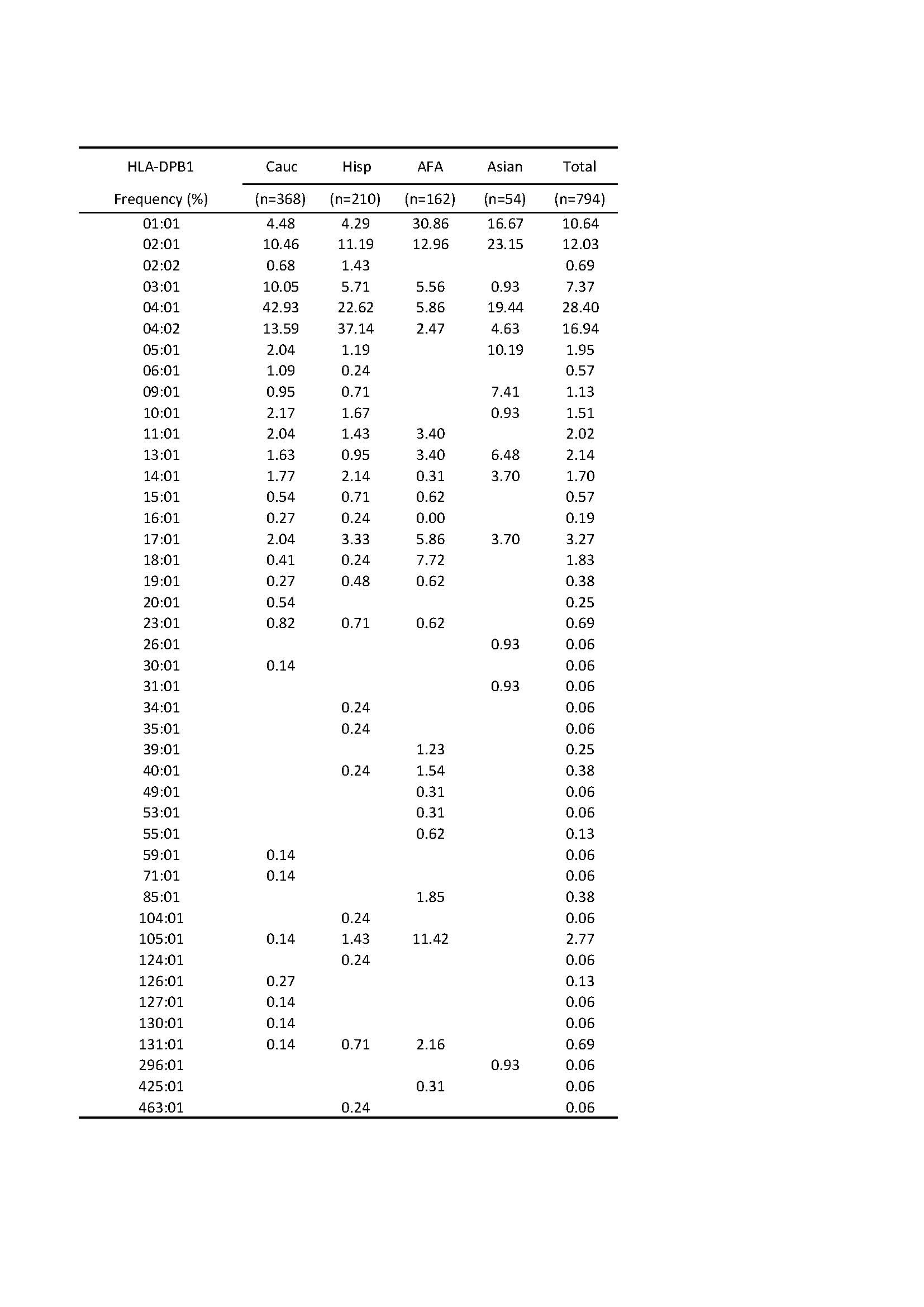HLA-DPA1 and HLA-DPB1 Frequencies in the US Populations.
Pathology, Loyola University Medical Center, Maywood, IL
Meeting: 2017 American Transplant Congress
Abstract number: B45
Keywords: Allocation, Antibodies, Histocompatibility, Histocompatibility antigens
Session Information
Session Name: Poster Session B: Allorecognition and T Cell Biology
Session Type: Poster Session
Date: Sunday, April 30, 2017
Session Time: 6:00pm-7:00pm
 Presentation Time: 6:00pm-7:00pm
Presentation Time: 6:00pm-7:00pm
Location: Hall D1
Aim: HLA-DP antibodies can elicit positive crossmatches and be detrimental in organ transplantation. Although HLA-DP unacceptable antigens can be input in the UNOS database, they do not take weights in cPRA calculations. As rapidly increased HLA-DPB1 alleles are reported, the limited HLA-DP antibodies can be detected by the advanced Luminex solid phase assays. In addition, the data of the frequencies of HLA-DPA1 and HLA-DPB1 antigens is lacking. We analyzed 794 solid organ transplant candidates and live donors typed in our center to illustrate the polymorphisms of HLA-DPA1 and –DPB1 distributions in the US populations.
Methods: HLA-DPB1 typing was performed by LabType rSSOP (One Labmda, Thermal-Fisher)
Results: Among 794 typed patients and donors, 46.3% were Caucasians (Cauc), 26.4% Hispanics (Hisp), 20.4% African Americans (AFA) and 6.8% Asians. There are 8 HLA-DPA1 antigens and 43 HLA-DPB1 antigens were found. The common alleles were HLA-DPA1*01:03, followed by HLA-DPA1*02:01 and HLA-DPA1*02:02 in the populations. Besides these common alleles, HLA-DPA1*03:01 is the most common allele in AFA. While the most common alleles of HLA-DPB1 antigens were HLA-DPB1*04:01, -*04:02, *02:01 and *01:01 among the populations. Our data showed HLA-DPB1*04:01 (42.93%) and HLA-DPB1*04:02 (13.59%) in Cauc, HLA-DPB1*04:02 (37.14%) and HLA-DPB1*04:01 (22.62%) in Hisp, HLA-DPB1*01:01 (30.86%) and HLA-DPB1*02:01(12.96%) in AFA and HLA-DPB1*02:01 (23.15%) and HLA-DPB1 (19.44%) in Asians. Certain HLA-DPB1 alleles appear ethnically limited, for example, high frequencies of HLA-DPB1*05:01 (10.09%) and HLA–DPB1*09:01 (7.41%) were seen in Asians, but not seen in AFA. In addition, common alleles of HLA-DPB1 are not selected in current available Luminex single antigen kits which may cause the false negative virtual crossmatch.
Conclusions: While lacking the donor DP typing, this study may aid donor selection, donor specific antibody interpretation and virtual crossmatch and antibody reagent development.
CITATION INFORMATION: Du Z, Patel J, Braun C, Norton B. HLA-DPA1 and HLA-DPB1 Frequencies in the US Populations. Am J Transplant. 2017;17 (suppl 3).
To cite this abstract in AMA style:
Du Z, Patel J, Braun C, Norton B. HLA-DPA1 and HLA-DPB1 Frequencies in the US Populations. [abstract]. Am J Transplant. 2017; 17 (suppl 3). https://atcmeetingabstracts.com/abstract/hla-dpa1-and-hla-dpb1-frequencies-in-the-us-populations/. Accessed December 14, 2025.« Back to 2017 American Transplant Congress
